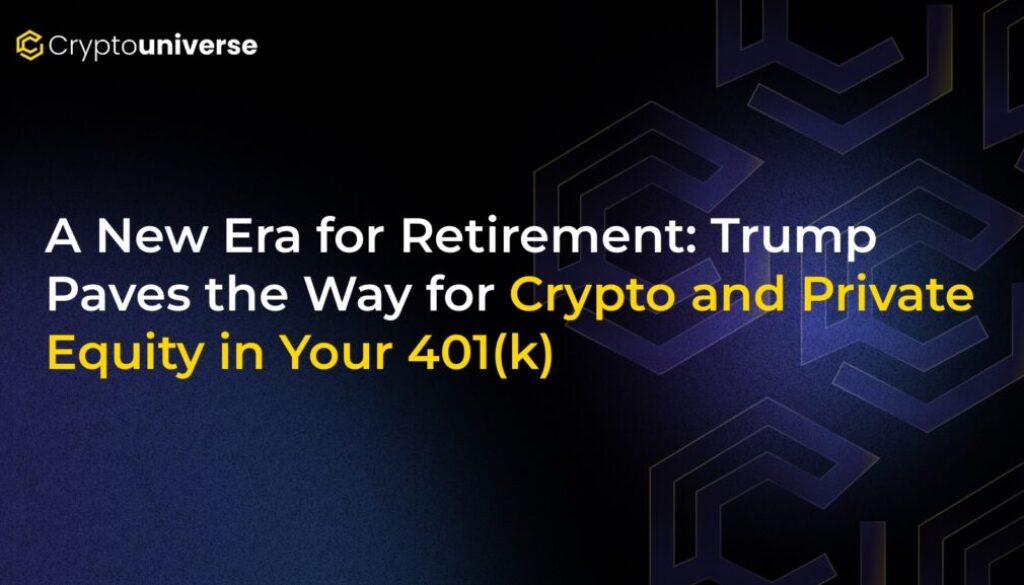A New Era for Retirement: Trump Paves the Way for Crypto and Private Equity in Your 401(k)

A Landmark Shift in American Retirement Savings
In a move that could fundamentally reshape the landscape of American retirement, President Donald Trump has signed a pivotal executive order. This directive aims to open the door for millions of 401(k) account holders to invest in alternative assets, including private equity and cryptocurrency. The order sets in motion a regulatory review that could unlock a staggering pool of capital—worth trillions of dollars—for these historically restricted markets.
While the changes won’t happen overnight, this executive action signals a major philosophical shift in how retirement savings are managed, potentially offering both higher returns and higher risks to the average American investor.
What Does the Executive Order Actually Do?
The core of the executive order is a directive to the Labor Department and other federal agencies. Their task is to review and redefine the rules under the Employee Retirement Income Security Act of 1974, better known as ERISA.
ERISA is the foundational law governing most private-sector retirement and health plans. A key part of ERISA is the “fiduciary duty,” which legally requires employers and plan managers to act in the best financial interests of their employees. For decades, this has meant that 401(k) plans have been dominated by traditional, liquid assets like stocks, bonds, and mutual funds.
This new order challenges that tradition by asking regulators to consider broadening the definition of a “qualified asset” to include:
- Cryptocurrency: Digital assets like Bitcoin and Ethereum.
- Private Equity: Investments in private companies that are not listed on a public stock exchange.
- Real Estate: Direct or fund-based investments in property.
This is a long-sought victory for both the $5 trillion private equity industry and the burgeoning crypto sector, which have been eager to gain access to the massive 401(k) market.
The Pros: A Case for Greater Choice and Higher Returns
Supporters of the move argue that it modernizes retirement investing and gives Americans the freedom to build wealth through a more diverse set of tools. Here are the main arguments in favor:
1. Potential for Higher Returns
Alternative assets often carry the potential for outsized returns. Historically, private equity has outperformed the public market. According to data from Cambridge Associates, private equity has delivered an average annual return of around 13% since 1990, compared to the S&P 500’s average of roughly 10.6% (including dividends) over the same period.
Similarly, while volatile, Bitcoin has been one of the best-performing assets of the last decade, generating immense wealth for early adopters. Proponents believe that even a small allocation to these assets could significantly boost a retirement portfolio over the long term.
2. Increased Diversification
A core tenet of modern investing is diversification. By adding assets that don’t always move in the same direction as the stock and bond markets, investors can potentially reduce overall portfolio risk. Including real estate, private equity, and crypto could provide a hedge against downturns in traditional markets.
3. Investor Freedom and Modernization
Many, especially younger investors, are already active in the crypto space and are eager to include it in their long-term plans. As Cory Klippsten, CEO of Swan Bitcoin, noted, “It was inevitable that bitcoin would make its way into American 401(k)’s. As fiduciaries realize bitcoin’s risk-adjusted upside over the long term, we’ll see growing allocations, especially from younger, tech-savvy workers.”
The Cons: Acknowledging the Significant Risks
The potential for higher returns comes with significant, undeniable risks. The previous administration urged “extreme care” with crypto for good reason. Critics of the new order point to several major concerns:
1. Extreme Volatility
Cryptocurrency markets are notoriously volatile. It’s not uncommon for assets like Bitcoin to swing 10% or more in a single day. For comparison, a 2-3% move in the stock market is considered a major event. This level of volatility can be devastating for individuals nearing retirement who don’t have time to recover from a sharp downturn.
2. Illiquidity and Lock-Up Periods
Unlike stocks, which can be bought and sold instantly, private equity investments are highly illiquid. Capital is often locked up for years until the private company is sold or goes public. This lack of access to your own money can be a major issue in a personal retirement account, where you might need to access funds unexpectedly.
3. Complexity and Higher Fees
Alternative assets are more complex and typically come with much higher management fees than a standard S&P 500 index fund. These fees can eat into returns over time, and the complexity can make it difficult for the average investor to understand exactly what they own.
What This Means for Your 401(k) Today
It’s crucial to understand that nothing changes immediately. Your 401(k) investment options remain the same for now. The executive order is the first step in a long process.
Here’s what to expect:
- Regulatory Rulemaking: Federal agencies will spend months, or possibly longer, drafting and finalizing new regulations.
- Product Development: Major retirement plan providers like Fidelity, Vanguard, and T. Rowe Price will need to develop and vet new funds that offer these alternative assets in a way that is suitable for 401(k) plans.
- Employer Adoption: Finally, your employer would have to choose to adopt these new funds and offer them as part of your company’s retirement plan.
This entire process could take several years. Even major players are proceeding with caution. Vanguard stated it is focused on educating investors about the risks and has not yet committed to launching a private asset product for 401(k) plans.
The Bottom Line
The decision to open the door for
However, this new freedom comes with a heavy dose of responsibility and risk. As these options potentially become available, it will be more important than ever for investors to educate themselves, understand their own risk tolerance, and carefully consider whether these volatile and complex assets have a place in their long-term financial future.


